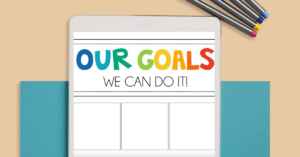So, there I was, planning for my very first therapy session in grad school. I was feeling pretty good! I prepped some fun games and activities. I was ready!
But then it hit me.
I have a great set of activities, but how in the world am I going to teach this client? How am I going to help her produce a sound she’s never produced before? Where do I start?!
NOTE: The links below are Amazon Affiliate links for your convenience, but I may receive compensation if you click through and purchase one of the books. *
My First Teaching Plan
Luckily, I was able to come up with a plan using what I was learning in my graduate school classes. I used the infamous Eliciting Sounds book* for some shaping strategies. I also knew about cueing/prompting hierarchies and the “articulation ladder” (starting with sounds in isolation, moving towards conversation).
Whew. I had a plan to teach skills in therapy.
The Problem with Language
Then, I started planning sessions for students with language goals. I got so caught up in the book, the activities, and all the extra stuff that I actually forgot to think about actually teaching the skill! Years later, I still do sometimes!
The tricky part is that language often isn’t as clear-cut as articulation. With articulation, I can tell my student where to place his tongue. I can quickly assess using what I see and hear to give appropriate feedback. Teaching is (usually) pretty simple!
With language, however, so many factors come into play. It’s relatively simple to tell a student what to do, but the how is trickier. Unfortunately, there isn’t an Eliciting Language book with all the best secrets! (Believe me, I checked!)
I knew I had to do something. I knew that the worksheets and drill practice weren’t cutting it. I started using a “therapy template” (check in, goals, teach/practice, wrap up) and set aside time to teach every session. With a large caseload and a general lack of experience, I was really struggling to find effective ways to teach these skills.
My Plan
I knew this would take some time, so I made a list of the skills that my students were working on. I highlighted the ones I was really struggling with. Then, I started chipping away! I started creating teaching visuals (sometimes with the student in therapy). I also looked towards the evidence for additional strategies and tools.
After several months, I was able to build a toolbox full of teaching strategies and tools for my caseload. It made therapy so much easier! I felt like I could target any goal using any materials (more on that later).
There is still a little bit of work involved. I do still add to this toolbox as students come in with different goals or when the tools I created aren’t working for a particular student, but it’s way better than the mess I was dealing with before I had a “toolbox”!
Over time, I also started adding assessments to help me troubleshoot. The assessments allowed me to take a step back and pinpoint with which skills a student is struggling.
Keeping it Together
I needed a way to keep these tools organized so that I would actually be able to quickly find (and use them) in therapy!
How to Teach
So that’s great. I have a “toolbox.” But how does that help me teach?
There’s actually an easy four-step process for that!
1. When I’m working with a student on a new goal, we walk through the teaching sheet to introduce the skill. (This is a great opportunity to talk about the why! Why does this skill matter? How will the student use this skill?)
2. I model the skill. For example, if we’re working on context clues, then I’ll show them how I would use the strategy to define a word that I don’t know. Lots of meta talk here! (:
3. Then, I give the student an opportunity to practice. The “toolbox” I created includes some quick practice activities, but we don’t spend much time here.
4. Finally, we jump into context. We start practicing the skill using books, reading passages, or any other relevant classroom activities.
If you don’t know already, I’m a huge fan of curriculum-based therapy and contextualized intervention.* It really helps with generalization and–don’t tell anyone–but it’s actually kind of easy!
This involves using scaffolding and support (rather than using simpler, decontextualized worksheets and activities).
I decrease the level of support as the student makes progress.
I repeat the process during the Teach/Practice part of each session. Sometimes we go through all four steps; sometimes we get stuck on one step for the entire session. Either way, this rough framework helps to structure the session (for me and my students).
Time to Share
Do you want to step up your teaching strategies?
I started sharing my resources, and I’m excited to start a series of blog posts featuring some of the strategies and tools that I’ve found to be the most helpful. Let me know which skills you’d like to hear about by leaving a comment below!
If you want access to the “toolbox” right away, then you can sign up for the SLP Now Membership.
* Marisha McGrorty is a participant in the Amazon Services LLC Associates Program, an affiliate advertising program designed to provide a means for sites to earn advertising fees by advertising and linking to Amazon properties including, but not limited to, amazon.com, endless.com, myhabit.com, smallparts.com, or amazonwireless.com.






Leave a Reply